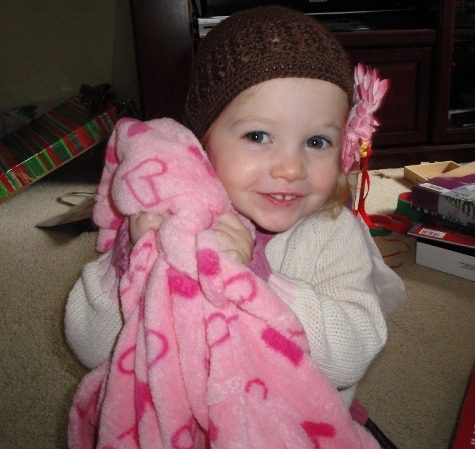The following post is from Katie of Kitchen Stewardship: 3 Ways to Get the Flame Retardant out of Your Kids’ Fuzzy Pajamas

It kills me that other moms are forking out bucks for chemicals to “redo” the diminished flame retardant quality in their kids’ year-old pajamas while I’m going to great lengths to avoid them and get the fire retardants out to protect my kids’ health.
Table of Contents
Did You Know?
Did you know the federal government, via the Consumer Products Safety Commission, has mandated since 1972 that all children’s sleepwear through size 6X must be flame retardant?
This almost always comes to fruition through added chemicals, which may be off-gassing toxic fumes around your children as they sleep. (In the late 90s the standards were updated to exempt tight-fitting pajamas and sleepwear for children under 9 months old.)
Even my husband, who doesn’t always think critically or environmentally about things with me, wrinkled his brow when I explained that it’s a law and said, “What credentials do the legislators have to decide what is safest for kids?
Why pajamas?
That doesn’t even make sense!” The flame retardant quality is not meant in any way to save lives in the case of a house fire, at which point smoke is generally the lethal force well before flames anyway.
The official language states that “fabrics…of children’s sleepwear garments must self-extinguish after exposure to a small open flame.” (source)
When my husband asked, “Why?” I guessed that some statistics came out demonstrating that kids were more likely to suffer burn injuries while in their pajamas than in their day clothes.
A little research made me shake my head in greater dismay than I expected:
“From 1967 through January 1973, FFACTS obtained information about 434 cases involving burn injuries associated with sleepwear, 101 of which involved children younger than six years of age.” (source, emphasis mine)
And get this:
Over 5,000 children were treated for burn injuries related to clothing in the four years between 1991 and 1994, even though only ninety kids were wearing sleepwear when they got burned from 1980-1994, fourteen years! (source)
Why do pajamas remain such a target?
I’m sure the parents of those 101 kids feel like their kids’ experience was the worst possible thing to ever happen to them, but let’s be serious here: one-hundred kids are the cause of pages upon pages and hours upon hours of government legislation?
And now ALL our children have to be subjected to chemicals???
It’s yet another case where I get a little political, which I hate to do, and shake my fist at “the government” for taking the choice out of my hands.
Sure, we have the option of only buying the tight jammies now, but my kids really like fuzzy PJs, and with our house at 61F, it’s kind of important that they have some with feet!
What are the health risks?
Besides the relatively low incidence of burn injuries in pajamas, there are serious health hazards to flame retardant chemicals.
Tris, one of the first flame retardants used on sleepwear, was banned after a few years because it caused cancer.
PBDEs, a class of flame retardant chemicals used more in mattresses or foam furniture rather than clothing, nonetheless may cause problems with neurodevelopment and hormone regulation.
They have been banned in Europe and are slowly being 100% phased out in the states. (source)
Flame retardants have been found in household dust, human breastmilk, and even grocery store food. Can we really trust that whatever is in our children’s PJs is safe? I’d rather take a chance with a “small, open flame,” to be honest.
For those of you who share my concern, here are 3 ways you can battle the chemicals so your kids aren’t breathing in the fumes from their flame-retardant sleepwear all night long.
1. Hang for a Year
Pardon the lack of source here, but back when I first started looking into this problem when my daughter was passing the 9-month mark, I found a source that said the chemicals should be off-gas simply by hanging up the pajamas for an entire year. I’m always thrilled to buy secondhand for this reason, and I’ve asked the grandparents to buy any new fuzzy jams a size too large. [Note: some disagree in the comments, so I think I’ll stick with no. 3 plus this one if I can.]
2. Wash in Soap
The CPSC standards state that the flame retardant quality must remain in effect for 50 washes in detergent. If you read the tag on any sleepwear that isn’t tight-fitting, you notice a few things:
- “Flame Resistant” – your cue you don’t want to buy it if you can help it.
- “To retain flame resistance, wash in detergent only, do not use soap” – Eureka! I read that as instructions to beat the system, don’t you?
The first thing I did with this year’s Christmas gift pajamas was to soak them in Castille soap and hot water. So there, flame retardant chemicals! (Note: Not everything that says “soap” is a soap. Charlie’s Soap is a natural laundry option that I’ve tried out, but it is actually a detergent.)
UPDATE: More good points in the comments, that the soap almost certainly diminishes the effect of the flame retardant chemicals. Most likely does not actually remove them from the fabric. Moving on to number three…
3. Soak in Acid
I was tweeting about my success with soap when another option popped up on my screen. The brilliant Lisa of Mama Says, whose husband has to wear flame retardant clothing for work, shared that any acid is also not supposed to come in contact with the fabric. She recommended soaking in Coca-Cola, which apparently cuts industrial oil stains when added to the wash. (And I let my husband drink that stuff? Gah!)
I chose vinegar as a less expensive and clear acid and soaked all the evil PJs for about two days in a 50/50 solution with water. You could also use lemon juice in a ratio of 1 cup to a gallon of water.
Onward with Warm Pajamas!
I’m sad that the fuzzy pajamas are almost always polyester, a plastic, which opens a whole new can of worms. But for now, let’s just be happy that we can, I think, fingers crossed, eradicate the flame retardant chemicals in the sleepwear we already have.
No need to snatch away your kids’ fuzzy or loose-fitting PJs that they receive for Christmas. Hopefully, we can rest a little easier with one of these methods. We try our best to purchase organic cotton for the 50% of the time that our children spend sleeping.
What do your kids wear to sleep?
| Katie Kimball is a mom of two who spends a ton of time in the kitchen making real food with whole ingredients and then blogs about her successes and failures at Kitchen Stewardship. She believes everything in life is a gift from God and should be taken care of wisely. |




